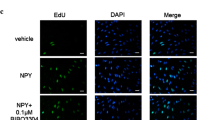Abstract
The effects of mevalonate depletion on growth and cell cycle kinetics of porcine and human vascular smooth muscle cells (SMC) were studied by growth curves and flow cytometric determination of cell cycle distribution. Porcine and human SMC were growth arrested by serum depletion for 48 h. Subsequently, they were stimulated to maximal growth and DNA synthesis by addition of serum. There was a concentration dependent decrease in the proliferation of human and porcine SMC, when cells were incubated in the presence of fluvastatin, a new, fully synthetic HMGCoA-reductase inhibitor. The reduction of cell number was significant with 10−5 M and 10−4 M fluvastatin. The highest concentration induced cell loss after prolonged incubation (>4 days). The G/S-phase transition of human and porcine vascular SMC was reduced to 50% of controls by 10−4 M fluvastatin as revealed by cell cycle analysis. The effects of fluvastatin on growth kinetics and cell cycle distribution could be completely reversed by the addition of 1 mM mevalonolactone. This indicates that the inhibitory effect of fluvastatin is caused by the inhibition of HMGCoA-reductase and depletion of mevalonate rather than being unspecific. Addition of LDL to supply cholesterol failed to support cell growth and transition of smooth muscle cells from G0/G1-phase to S-phase, even though LDL was taken up by the cells as shown by confocal fluorescence microscopy. Neither did the addition of squalene or cholesterol to the culture medium normalize cell growth. It is concluded that nonsterol products that are synthesized from mevalonate are necessary for growth of smooth muscle cells. HMGCoA-reductase inhibitors like fluvastatin block the synthesis of these nonsterol precursors in human and porcine vascular SMC in vitro and are therefore growth inhibitory.
Similar content being viewed by others
References
Bennis F, Favre G, LeGaillard F, Soula G (1993) Importance of mevalonate derived products in the control of HMG-CoA reductase activity and growth of human lung adenocarcinoma cell line A549. Int J Cancer 55: 640–645
Brown MS, Goldstein JL (1980) Multivalent feedback regulation of HMG CoA reductase, a control mechanism coordinating isoprenoid synthesis and cell growth. J Lipid Res 21: 505–517
Campbell JH, Campbell GR (1986) Endothelial cell influences on vascular smooth muscle cell phenotype. Ann Rev Physiol 38: 295–306
Campbell JH, Reardon MF, Campbell GR, Nestel PJ (1985) Metabolism of atherogenic lipoproteins by smooth muscle cells of different phenotype in culture. Arteriosclerosis 5: 318–328
Carlberg M, Hiertman M, Wejde J, Larsson O (1994) Mevalonate is essential for growth activation of human fibroblasts: Evidence for a critical role of protein glycosylation in the prereplicative period. Exp Cell Res 212: 359–366
Chamley-Campbell J, Campbell GR, Ross R (1981) Phenotype-dependent response of cultured aortic smooth muscle to serum mitogens. J Cell Biol 89: 379–387
Corsini A, Mazzotti M, Raiteri M, Soma MR, Gabbiani G, Fumagalli R, Paotetti R (1993) Relationship between mevalonate pathway and arterial myocyte proliferation: in vitro studies with inhibitors of HMG-CoA reductase. Atherosclerosis 101: 117–125
Deuel TF, Senior RM, Huang JS, Griffin GL (1982) Chemotaxis of monocytes and neutrophils to platelet-derived growth factor. J Clin Invest 69: 1046–1049
Doyle JW, KandutschAA (1988) Requirement for mevalonate in cycling cells: quantitative and temporal aspects. J Cell Physiol 137: 133–140
Fairbanks KP, Witte LD, Goddman DS (1984) Relationship between mevalonate and mitogenesis in human fibroblasts stimulated with platelet derived growth factor. J Biol Chem 259: 1546–1551
Habenicht AJR, Glomset JA, Ross R (1980) Relation of cholesterol and mevalonic acid to the cell cycle in smooth muscle and Swiss 3T3 cells stimulated to divide by plateled derived growth factor. J Biol Chem225: 5134–5140
Havel RJ, Eder HA, Bragdon JH (1955) Distribution and composition of ultracentrifugally separated lipoproteins in human plasma. J Clin Invest 34: 1345–1353
Jakobisiak M, Bruno S, Skierski JS, Darzynkiewicz Z (1991) Cell cycle specific effects of lovastatin. Proc Natl Acad Sci USA 88: 3628–3632
MAAS investigators (1994) Effect of simvastatin on coronary atheroma: the Multicentre Anti-Atheroma Study (MAAS). Lancet344: 633–638
Morisaki N, Kanzaki T, Fujiyama Y, Osawa I, Shiria K, Matsuoka N, Saito Y, Yoshida S (1985) Metabolism of n-3 polyunsaturated fatty acids and modification of phospholipids in cultured rabbit aortic smooth muscle cells. J Lipid Res 26: 930–938
Reimann FM, Herold G, Schneider A, Stange EF (1991) Compartmetalization of cholesterol metabolism and cellular growth in cultured intestinal crypt cells. Biochim Biophys Acta 1085: 315–321
Ross R (1993) The pathogenesis of atherosclerosis — a perspective for the 90's. Nature 362: 801–809
Ross R (1991) Polypeptide growth factors and atherosclerosis, Trends Cardiovasc Med 1: 277–285
Thyberg J, Hedin U, Sjölund M, Palmberg L, Bottger BA (1990) Regulation of differentiated properties of arterial smooth muscle cells. Arteriosclerosis 10: 966–990
Vindelov LL, Christenson IJ, Nissen NI (1983) A detergent-trypsin method for the preparation of nuclei for flow cytomentric DNA analysis. Cytomentry 3: 323–327
Waters D, Higginson L, Gladstone P, Kimball B, Le-May M, Boccuzzi SJ, Lesperance J (1994) Effects of monotherapy with an HMG-CoA reductase inhibitor on the proression of coronary atherosclerosis as assessed by serial quantitative arteriography. The Canadian Atherosclerosis Intervention Trial. Circulation 89: 959–968
Wejde J, Carlberg M, Hjertman M, Larsson O (1993) Isoprenoid regulation of cell growth: identification of mevalonate labelled compounds inducing DNA-synthesis in human breast cancer cells depleted of serum and mevalonate. J Cell Physiol 155: 539–548
Author information
Authors and Affiliations
Rights and permissions
About this article
Cite this article
Rogler, G., Lackner, K.J. & Schmitz, G. Mevalonate is essential for growth of porcine and human vascular smooth muscle cells in vitro. Basic Res Cardiol 90, 443–450 (1995). https://doi.org/10.1007/BF00788536
Received:
Revised:
Accepted:
Issue Date:
DOI: https://doi.org/10.1007/BF00788536




